June is an important month for Bissell Centre – it’s both Pride Month and National Indigenous History Month. There is a close connection between what Pride Month is all about and Indigenous history in our country.
Countless Indigenous Nations across what’s now called North America saw Two-Spirit Peoples as not only an engrained and normalized part of their culture — Two-Spirit Peoples were often highly regarded and seen as a gift from the Creator.
“They were a very important part of Cree society,” says Elder Ed Lavallee. He is a traditional Plains Nehiyaw (Cree) of the Sturgeon Lake First Nation in Saskatchewan whose career in advocacy for Two-Spirit Peoples has seen him collaborate with groups like Pride Edmonton, the Edmonton Queer History Project, and the Edmonton 2 Spirit Society. Quotes from Elder Ed Lavallee reflect the distinct experience of the Plains Nehiyah Peoples.
“They had many roles in the daily lives of their people and were respected and revered for being Two-Spirited. They were often healers, shamans, mediators in marriage and tribal disputes, keepers of their history and their lore, and taking part and often leading in their social and Spiritual Ceremonies.”
While colonial efforts tried to wipe out any non-conformity from a person’s ascribed gender, the presence of these folks never went away. It wasn’t until 1990 that this way of being was finally given a general English translation to help people across Canada understand that, for countless Indigenous Peoples today, there are far more than only two genders.

The Five Genders
For Indigenous Nations in what’s now called Alberta, there are five genders in the community: male, female, male with female spirit, female with male spirit, and transgender.
“Indigenous people believe that both the female and male spirits reside in the body of a Two-Spirit Individual and the degree of dominance of each spirit ultimately impacts the physical, emotional, mental and spiritual identity of each Two-Spirit person,” says Elder Ed Lavallee.
Rather than trying to change people to better fit with the gender they were born with, Indigenous Nations instead made room for these people and ensured they could contribute to the community with the tasks and skills they identified with most.
Males with female spirits could take on cooking and cleaning duties, were widely seen as gifted artists, and some Nations even saw them adopt orphaned children to take on a caregiver role. Females with male spirits contributed by hunting and being warriors. Some Nations saw females with male spirit folks marrying widowed women.
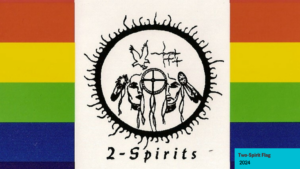
The Reverence for Two Spirit Peoples
In addition to the everyday contributions Two-Spirit Peoples made to their communities, their gift of having two spirits within them also meant they were good healers, medicine people, and visionaries. This is because the two spirits in them give them what’s called double-vision — the ability to see the world through both the male and female lens.
“The belief that Cree Two-Spirit People are special is epitomized in the existence of a powerful Two-Spirit Deity known as Qweskicanskew,” adds Elder Ed Lavallee. “In their spirituality, they believe this Spirit turns things around for the good and well-being of all things on earth. This important Spirit is called upon in prayers for help, protection and blessings.”
Two-Spirit Peoples were foundational to their communities. During colonization, Two-Spirit Peoples’ place in the world seemed to no longer exist. Through the mid- to late-twentieth century, as more Indigenous Peoples began to reclaim their identities, it was clear the different terms used in different Nations like Nádleehí (nad-lay-hee), Winkté (wink-tay), and Niso-acahk-iynew (nee-soh-achak-ee-noo) needed a translation for the wider public to understand.
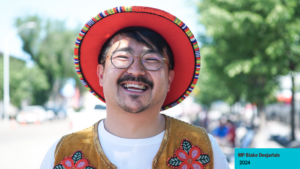
Bringing Two Spirit to the Wider Public
In 1990, at the Third Annual Intertribal Native American, First Nations, Gay and Lesbian American Conference, Elder Myra Laramee put forth the term Two-Spirit. The term is a translation from the Anishnaabemowin (Ojibwe language) term Niizh Manidoowag (neez man-ee-doo-wog). It was added to the front of the Pride acronym (2SLGBTQIA+) in recent years and was even a part of the focus for the Federal 2SLGBTQIA+ Action Plan launched in 2022.
Today, knowledge and understanding about Two-Spirit Peoples is spreading, but is still far behind from where it was before colonization. People like Dr. James Makokis (a Two-Spirit doctor from Kehewin Cree Nation) and MP Blake Desjarlais (a Member of Parliament from Edmonton) are sharing their stories to help more people understand why Two-Spirit Peoples are an essential part of their Nations – and to reduce the stigmatization around people living their authentic lives.
“They are emerging from their long decades of oppression and marginalization working toward re-establishing their rightful roles in their communities as they go through this period of rediscovery,” says Elder Ed Lavalle. “They are working to be recognized, respected and engaged in an integral manner, within Indigenous communities and society in general.”
This Pride Month and National Indigenous History Month, we’re celebrating the bravery of Two-Spirit people coming out and bringing this piece of Indigenous culture to the public forefront. We hope you’ll join us in making room for Peoples who can walk in both worlds to share their gifts and help make this world a more equitable place for everyone.
The role family plays in many Indigenous cultures can’t be understated. Blood familial ties and chosen families can hold the most sacredness and honour for Peoples in Indigenous Nations. The Community at Bissell Centre is no different.
Those strong family ties are especially prevalent at our National Indigenous Peoples’ Day (NIPD) event outside our Community Space (10530 96 Street) every June 21. This is a day of celebration where we block off part of the street, invite performers and artists to share their crafts, and serve some of the best Indigenous cuisine you can find in the city.
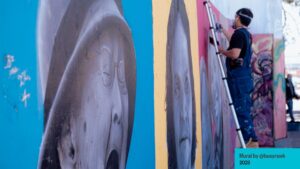
The Reverence held for Elders
Honouring Elders is one of the most important customs of NIPD. The knowledge and teachings these individuals hold in the communities not only preserves the traditional ceremonies and rituals that bring so much vibrancy and life to Indigenous Nations – they can also help guide individuals through challenges and onto the most life-affirming paths.
“One of the most important services we can offer with Bissell’s Indigenous Engagement Program is connecting individuals to Elders,” explains Sarah Higgins, Director of Indigenous Engagement and Integrated Family Services – and a Red River Métis woman. “The teachings and guidance Elders can provide and the connection they foster to Indigenous Nations can help a person decide it’s time to reach out for further supports in their unique journey out of poverty.”
At the NIPD event, you’ll see a tent specifically for Elders to sit in. They’re often accompanied by children from Indigenous Nations, as well, symbolizing how their knowledge will be passed down through generations to ensure the culture and traditions remain a vital part to one’s Indigenous identity.
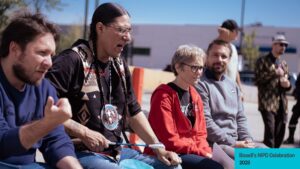
The Crucial Chosen Families Built in the Community
For people accessing the services at Bissell Centre, families by blood aren’t always a part of their lives, yet the importance of family never really goes away for a lot of folks. Creating new chosen families then becomes a part of life in the community.
“It’s not uncommon to see folks in the community calling each other uncle, aunty, or cousin because this is the family they’ve built for themselves,” says Higgins. “Just like a family, these are support systems for each other and we see these connections as real family – just the same as any blood tie.”
Families and communities coming together to celebrate the resiliency of Indigenous Peoples shows how important NIPD is for the folks in downtown Edmonton. And no matter what that family looks like and who makes up that unique family unit, NIPD will have space for all who attend to celebrate the strength, culture, and customs from Indigenous Nations.
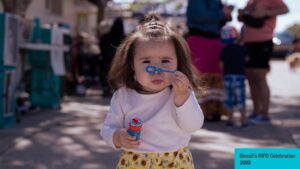
We can’t say enough about our Community Space. This is the central hub where folks can come by for a hot meal, hot shower, fresh clothes, and to build relationships with people to grow their support network.
This space is invaluable to the folks who access its services every day. And, this is why our biggest fundraiser of the year, our Coldest Night of the Year walkathon, sees money raised going directly back into the operations and programs in the Community Space. For a lot of folks, this space is so much more than a warm, indoor place to meet daily necessities – it can also be the first step towards finding their unique pathways out of poverty.

Relationships are everything in the Community Space.
While things like meals and showers might be what first brings people through the doors, they soon learn what other programs might help them along. We offer programs like housing, employment, and mental health, to name a few, which help uncover what barriers people are facing. As staff work to build relationships with people to help find their strengths, folks can start recognizing how best to address these root causes.
No two experiences with houselessness are alike. Building positive relationships can help people recognize their strengths and resiliency – ultimately helping them find their path out of poverty. And, when they’re ready to take those first steps in their journey, Bissell Centre staff help find the resources they need to live a good quality of life.
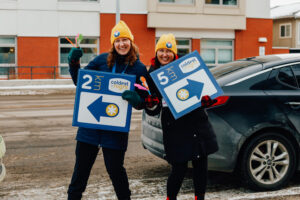
Every journey is unique – and everyone gives back differently.
Doug has been coming to the Community Space for a few years now. In his own words, it’s his home away from home. The relationships he’s built are like family to him. And like any good family, he finds ways to give back.
The main way Doug gives back to the Community Space is by volunteering in the Community Closet, helping folks find new clothes. Other times, Doug walks around the encampments nearby to see if anyone needs any help. Any way that Doug can help, he wants to offer it to the community that’s given him so much.
“If it weren’t for Bissell Centre, I think we’d all be lost,” says Doug. “They’re helping me out, so I want to help them out too.”

How you can help too.
This year’s Coldest Night of the Year fundraising walk sees all proceeds raised going directly back to the Community Space to support its invaluable operations and programs. Start a team, raise some money, and bring out the whole family for a walk downtown on February 24, 2024. Thank you to all our event sponsors, including our Lead Sponsor Capital Power for providing the single largest sponsorship contribution we have ever received.
Ten years ago, RJ Formanek wanted to start a conversation about Fetal Alcohol Spectrum Disorder (FASD). As an adult who has FASD, he thought educating people and showcasing his diverse skillset and reliance was important. And the Red Shoe Walk was born.
RJ figured he should stand out – red shoes did the trick. With his crimson kicks, RJ took to the street, stopping to talk with anyone willing to learn about FASD. And no wonder he wanted to start a conversation about FASD – especially when it feels like no one is talking about FASD.
This year, our Red Shoe Day Event sees us walking from Hope Terrace, our supportive living apartment for folks with FASD, through the King Edward Park community, and all through Bonnie Doon and into Strathcona and then returning to have lunch and an art sale at the Shamrock Curling Club. The art sale will feature artists who have FASD. Register today to join us on September 9 from 10:30 a.m. to 2:00 p.m. for a Red Shoe Walk through the community and bring awareness to a disorder that needs to be talked about more.
4% of Canada’s population has FASD
There are more people in Canada who have FASD than autism, cerebral palsy, and Down syndrome combined. And no two people who have FASD are alike. Many people who have FASD have rewarding careers and fulfilling lives – they uncover their strengths and lean on them to find success.
FASD affects people differently depending on when alcohol was introduced to their fetal development. Alcohol slows down development, both physically and mentally. This means how FASD affects a person is highly individualized, often requiring individualized programs and supports to help them live with dignity.
FASD is a hidden disability as most people who have FASD have no physical signs of impairments. Adolescents and adults who have FASD can experience high rates of difficulties in daily living and adverse outcomes, including school disruption, mental health issues, and challenges with independence. This is why the Red Shoe Walk is so important.
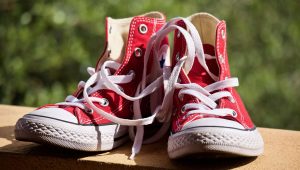
There is shame in an FASD diagnosis
Often, people miss or never receive an FASD diagnosis because of the shame involved – not on the people who have FASD, but on those who carried them in utero. There are ad campaigns and information packages all over highlighting the risks of drinking alcohol while pregnant.
A person may consume alcohol while pregnant without ever knowing they’re affecting the fetus they carry. They may not know they’re pregnant, have been told a little alcohol doesn’t hurt, come from a community where that information isn’t available, are experiencing mental health or stress-related illnesses prompting them to drink, or for many other reasons that have nothing to do with other issues like poverty. With a better understanding of how a person can end up consuming alcohol while pregnant, we can better understand FASD.
FASD can affect anyone – not only people in poverty
A common misconception around FASD is it only affects people experiencing poverty – we know this is false. People who have FASD can come from a range of backgrounds and situations, sometimes even from affluent families. We’ve seen this firsthand at Bissell Centre with participants in different programs telling us their stories and experiences.
Where the issue around poverty gets cloudy is how people who have FASD can be more likely to experience houselessness. That difference in understanding and mental processing can make navigating systems that we take for granted more difficult. We designed our programs specifically with this in mind – ensuring that services for folks who have FASD are readily available no matter the individuals’ personal circumstances.
Helping people live with dignity
Our Fetal Alcohol Spectrum of Services (FASS) program works to understand individuals who have FASD as whole people. We work one-on-one with our program participants to identify their unique strengths to guide them toward personal fulfillment.
Part of our FASS program is Hope Terrace. This is a supportive housing building specifically designed for people who have FASD. Wraparound services for FASD are included in this building, which also features a Snoezelen room to help individuals with emotional regulation.
Recently, a group from our FASS program contributed to the book Born Broken, detailing what our participants found most important to them in their own voices. This book highlights what folks who have FASD have to offer the world, their fears and struggles, and how they’re moving forward.
Maybe no one is talking about FASD simply because they don’t understand it. On September 9, keep an eye out for some folks walking all in Red Shoes. Ask questions about FASD and the Red Shoe Walk to ensure we are all talking about FASD.

Bissell’s National Indigenous Peoples Day celebration weeks ago brought 96 St. right outside Bissell to life. Bissell Centre has been celebrating National Indigenous Peoples Day, proclaimed in 1996 by the Canadian Government, for well over a decade! This year, it was so much more than a block party– our team made sure this was a celebration to remember.

Keeping Traditions Alive
Our Food Services kitchen team made traditional stew and Bannock for everyone who attended. In total, they served more than 900 meals! Elders from the community held a traditional pipe ceremony to kick things off. They shared stories of struggle and expressed why the customs and traditions they grew up with are so important to folks from Indigenous communities.
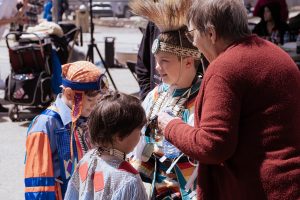
Energetic Local Performances
Families enjoyed the traditional hand games from Indigenous communities. Plus, dance and music performances from the Thunder Lake Singers & Dancers and flutist Theo Waskahat. The block was alive with music, drumming, and dancing for the whole community to enjoy.
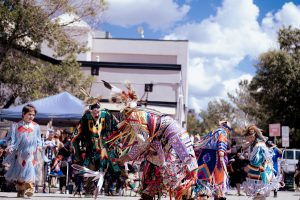
Sharing and Learning Together
National Indigenous Peoples Day is always an amazing celebration, but this year’s was truly one to remember. We’re so happy and grateful for everyone who came out, participated, shared their gifts, and helped make sure Indigenous customs and traditions will stay alive for the people who need them most.
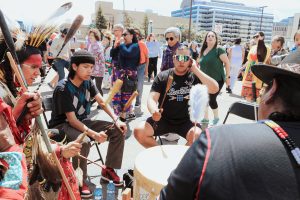
National Indigenous Peoples Day 2023 Photo Highlights
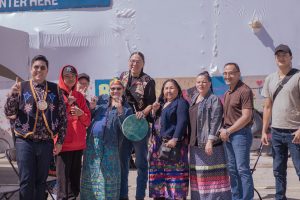
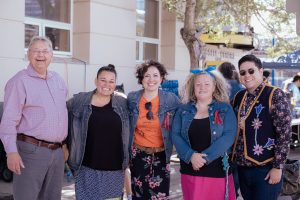
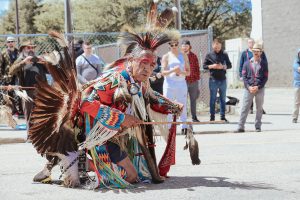



In 2022, Bissell Centre took a long hard look at itself and asked what can be a scary question – what are our 2SLGBTQIA+ team and community members experiencing here? What does Pride at Bissell look like? Are these folks being embraced and celebrated? Are they comfortable being their truest selves here?
41 team members participated in a survey focused on 2SLGBTQIA+ issues – 12 from 2SLGBTQIA+ communities. The results of the survey were promising, and a lot of organizations would take that as a sweeping success and end their efforts there. Instead, we wondered how best to push our organization even further.
Through the results of this survey, summer intern J. Heber looked at the qualitative stats, thought about how they represented the diverse 2SLGBTQIA+ presence at Bissell Centre, and created a fibre art piece to represent that diversity across the organizations.
It is an expression of all the different flags and colours that express the different gender identities and sexual orientations that makeup Pride. Today, it proudly hangs in our Community Space. It stands as a reminder to folks that our diversity is our strength, and inclusion is essential. It also features seeds and the words, “Let’s Grow Together,” demonstrating the seeds of compassion and the thirst for knowledge that helps us all better understand and appreciate one another.
We’re going to let our 2SLGBTQIA+ staff members speak for themselves. Exploring, in their own words, how Bissell Centre is working to improve equity for 2SLGBTQIA+ folks, what their experiences have been like at Bissell, and what Pride month means to them.

Allen
Bissell Centre gives out free rainbow stickers to everyone. I want to point this out first and foremost. It’s the first thing I think about when I think about how Bissell Centre is a safe space.
I joined Bissell Centre in 2020, and I wasn’t sure if I should be open about my gender identity. I saw a lot of staff here be comfortable and open and safe with who they are. Everyone here makes the effort to use my preferred pronouns (he/him) – and anyone who mistakenly uses the wrong pronouns is quick to apologize and correct it. That makes me feel respected and cared for by Bissell Centre.
Especially compared to my home country, Bissell Centre is welcoming to who I truly am. Here, I get to show my Pride without shame or any fear. I get to be open, and that’s important not just for me but for anyone who wants to express their Pride.
Even our community participants treat 2SLGCTQIA+ people with respect and equality. No one ever has anything negative to say about the clothes we choose, how we present, or how we choose to look according to our gender identity. Having this freedom and acceptance is so important for 2SLGBTQIA+ folks and how we can contribute back to our communities.
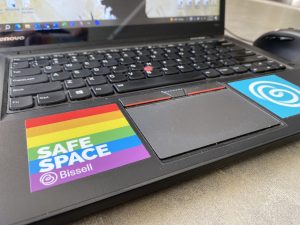
Clinton
When I was placed at Bissell Centre for my social work practicum, I was nervous about entering a new space. Being a member of the 2SLGBTQIA+ community, I am always wary when entering a new space. I don’t know if it’s safe, if I will be harassed or if I can truly be myself.
I remember about a month into my practicum, I mentioned how I noticed there wasn’t really any noticeable visual representation to let new staff and community members know that Bissell is a queer-friendly space. So, we came up with the idea for me to create a 2SLGBTQIA+ resource list for both staff and community members.
Then, I started noticing pride flag stickers placed on doors and laptops. My supervisor told me because I had the courage to identify the gap between Bissell and the queer community, she ordered gender-neutral bathroom signs for the bathrooms in the Community Space. I couldn’t believe that I was a catalyst for these changes. Bissell Centre is not just another group that celebrates pride once a year. They listen to the concerns people have and do what they can to improve.
The community members make Bissell Centre different too. I often get comments that I give off two-spirit energy. I learned that two-spirit folks in Indigenous culture are sacred, which makes me feel honoured. I don’t currently identify as two-spirit – the community members made me curious, and I have since been exploring that side of myself. Because the community members and the staff have created a judgment-free space, it has allowed me to safely be my true self.

Every year, Tim Horton’s holds its Smile Cookie fundraiser, where each local franchise owner can pick a charity in their community that the proceeds from cookie sales will support. It’s a great way to help raise money for great causes directly in our communities!
This year, a group of Edmonton franchise owners decided to try something different. The group agreed to pool their efforts to make a larger collective impact – ultimately choosing Bissell Centre as their charity of choice.
And just like that, this quickly became one of the largest fundraising campaigns we’ve held – raising more than $400,000 in a single week.
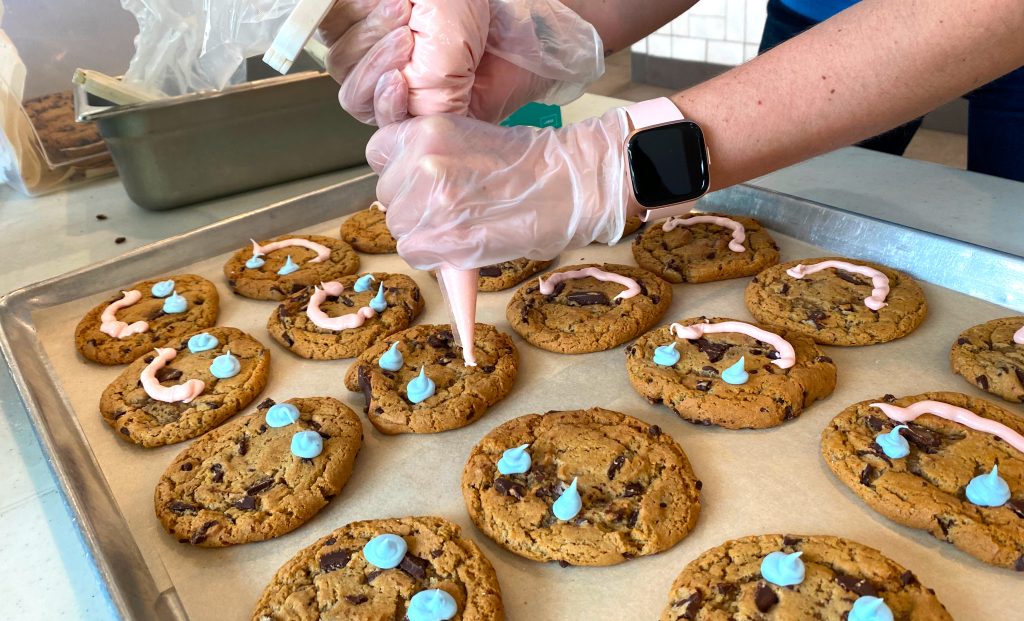
Bissell’s Child and Family Supports
Funds from this spring’s Smile Cookie campaign all went to support our Child and Family Supports Program. Last year, we helped more than 1,600 families find their way out of poverty and emergency situations. These programs make a massive impact that people in Edmonton don’t often see.
“It’s things like connections to free pre-natal care, parental supports, or free access to emergency essentials like diapers and formula,” says Jonathan Mackereth, Development Officer with Bissell Centre.
Mackereth explains that Bissell has run a childcare for more than 50 years, serving families in the downtown core. The centre is fully staffed by Early Childhood Education professionals, providing Early Childhood Development for short- and long-term – serving childcare from newborns to six years old.
“There’s are enough challenges finding quality childcare – finances shouldn’t be one of them,” says Mackereth “Lots of parents even drop-off their kids to access other programs like our Employment Services or Financial Empowerment workshops, making it an essential part of our approach to ending poverty.”

Supporting and Celebrating Together
Learning that 147 Tim’s locations all came together to support Bissell Centre, “caught us a little off guard,” Jonathan jokes. “We knew right away opportunities like this don’t come often. We pooled resources into making sure folks knew that buying a cookie would help a child.”
Team members from Bissell Centre could be found at a few different locations around the city during this campaign. Whether it was celebrating with giant cookie cut-outs by the drive-thru, or putting on hair nets and decorating cookies, the teams stepped up to make the week unforgettable.
By the end of the campaign, more than 300,000 cookies were sold – raising more than $464,000! People didn’t hesitate to add a smile cookie to their regular double-double orders – with some businesses and schools pre-ordering up to 1,500 cookies at a time.
“On the first day, we had a manager come out to see us,” Jonathan recalls. “She said in the first two hours of the morning rush, they sold more than a quarter of the cookies they sold for the entire campaign last year.”
We can’t thank the Edmonton Tim’s franchisees enough for all the support they’ve given us. This will directly impact families and children experiencing houselessness and poverty in Edmonton. Thank you for helping us make Edmonton a little bit more of an equitable place to call home.


























